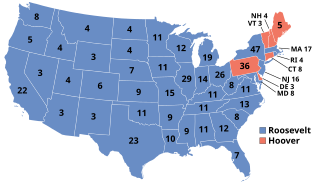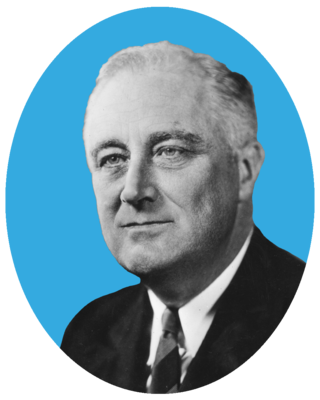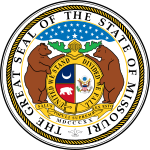
Presidential elections were held in the United States on November 8, 1932. Against the backdrop of the Great Depression, incumbent Republican President Herbert Hoover was defeated in a landslide by Democrat Franklin D. Roosevelt, the governor of New York and the vice presidential nominee of the 1920 presidential election. Roosevelt was the first Democrat in 80 years to simultaneously win an outright majority of the electoral college and popular vote, a feat last accomplished by Franklin Pierce in 1852, as well as the first Democrat in 56 years to win a majority of the popular vote, which was last achieved by Samuel J. Tilden in 1876. Roosevelt was the last sitting governor to be elected president until Bill Clinton in 1992. Hoover became the first incumbent president to lose an election to another term since William Howard Taft in 1912, the last to do so until Gerald Ford lost 44 years later, and the last elected incumbent president to do so until Jimmy Carter lost 48 years later. The election marked the effective end of the Fourth Party System, which had been dominated by Republicans. It was the first time since 1916 that a Democrat was elected president.

William Frederick Lemke was an American politician who represented North Dakota in the United States House of Representatives as a member of the Republican Party. He was also the Union Party's presidential candidate in the 1936 presidential election.

Guy Brasfield Park was an American politician from the U.S. state of Missouri.
Law Preservation Party was the name used in the State of New York by the Prohibition Party during the early 1930s. The name change was done to affirm their support of the continuance of Prohibition in the United States in the face of widespread opposition which ended with the passing of the 21st Amendment in 1933.

The 1932 Democratic National Convention was held in Chicago, Illinois June 27 – July 2, 1932. The convention resulted in the nomination of Governor Franklin D. Roosevelt of New York for president and Speaker of the House John N. Garner from Texas for vice president. Beulah Rebecca Hooks Hannah Tingley was a member of the Democratic National Committee and Chair of the Democratic Party of Florida. She seconded the nomination of Franklin Delano Roosevelt, becoming the second woman to address a Democratic National Convention. According to the White House Historical Association, Happy Days Are Here Again was the campaign song of the convention.
The 1884 Democratic National Convention was held July 8–11, 1884 and chose Governor Grover Cleveland of New York their presidential nominee with the former Governor Thomas A. Hendricks of Indiana as the vice presidential nominee.

The 1934 United States Senate election in Wisconsin was held on November 6, 1934.

The 1932 United States presidential election in Texas took place on November 8, 1932, as part of the 1932 United States presidential election, which was held throughout all contemporary 48 states. Voters chose 23 representatives, or electors to the Electoral College, who voted for president and vice president.

The 1932 Michigan gubernatorial election was held on November 8, 1932. Democratic nominee William Comstock defeated incumbent Republican Wilber M. Brucker with 54.92% of the vote.

The 1932 Colorado gubernatorial election was held on November 8, 1932. Democratic nominee Edwin C. Johnson defeated Republican nominee James D. Parriott with 57.23% of the vote.

The 1932 North Dakota gubernatorial election was held on November 8, 1932. Republican nominee William Langer defeated Democratic nominee Herbert C. DePuy with 54.75% of the vote.

The 1932 Washington gubernatorial election was held on November 8, 1932. Democratic nominee Clarence D. Martin defeated Republican nominee John Arthur Gellatly with 57.29% of the vote.

The 1932 Tennessee gubernatorial election was held on November 8, 1932. Democratic nominee Hill McAlister defeated Republican nominee John McCall and Independent nominee Lewis S. Pope with 42.8% of the vote.

The 1932 Wisconsin gubernatorial election was held on November 8, 1932. Incumbent Republican Governor Philip La Follette was defeated in the Republican primary, and in the midst of the Great Depression and nationwide voter dissatisfaction with the Republican Party, Democratic nominee Albert G. Schmedeman defeated Republican nominee Walter J. Kohler Sr. and Socialist nominee Frank Metcalfe with 52.48% of the vote. Schmedeman became the first Democrat to win a gubernatorial election in Wisconsin since George Wilbur Peck in 1892. Two years later, in 1934, La Follette would run for governor again and defeated Schmedeman, this time running with the Progressive Party.

The 1934 Wisconsin gubernatorial election was held on November 6, 1934. Primary elections were held on September 18, 1934. Incumbent Democratic Governor Albert G. Schmedeman was defeated by Progressive nominee Philip La Follette.

The 1932 South Dakota gubernatorial election was held on November 8, 1932. Incumbent Republican Governor Warren Green ran for re-election to a second term. He defeated former Governor Carl Gunderson in the Republican primary and faced former State Representative Tom Berry, the Democratic nominee, in the general election. Aided by Democratic presidential nominee Franklin D. Roosevelt's landslide victory in South Dakota, Berry defeated Green for re-election in a landslide.

The 1912 Wisconsin gubernatorial election was held on November 5, 1912. Primary elections were held on September 3, 1912.

The 1892 Wisconsin gubernatorial election was held on November 8, 1892. Incumbent Democratic Governor George Wilbur Peck narrowly defeated Republican nominee John Coit Spooner, becoming the first Democratic governor of Wisconsin to be reelected since Nelson Dewey in 1849.

The 1932 United States Senate elections in Colorado took place on November 8, 1932. Incumbent Republican Senator Charles W. Waterman announced that he would not seek re-election to a second term. Attorney Karl C. Schuyler won the Republican nomination to succeed Waterman and faced former Senator Alva B. Adams, the Democratic nominee, in the general election.




















